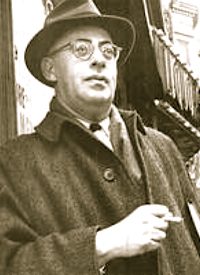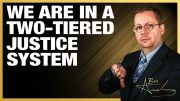
There has been a great deal of recent controversy surrounding the alleged presence of a portrait of Saul Alinsky (left) at the White House, an accusation put forward by GOP presidential hopeful Newt Gingrich. Thus far, the White House has sidestepped the issue, failing to give a clear indication of whether or not the portrait exists.
During a recent press briefing, Fox News Ed Henry asked Press Secretary Jay Carney to clarify whether the portrait is in fact hanging in the White House:
Newt Gingrich keeps saying on the campaign trail that the Presidents vision comes from Saul Alinsky, the community organizer. I haven’t heard you asked about him but Is there some kind of portrait of him hanging up in the White House that people look up to or is this BS?
Carney didn’t answer the question: The Presidents background as a community organizer is well documented in his own books. His experience in that field contributed to who he is today. But his experiences abroad also included a lot of other areas in his life. So Ill just leave it at that.
In a 2008 article in The New American entitled “Saul Alinsky: A Radical Who Matters,” Gregory Hession, J.D. observed,
Saul Alinsky, who died 36 years ago [now 40] and is only dimly known today, has had a major impact on the 2008 presidential election from the grave. He is a radical who matters, whose theories of political organizing are the lifeblood of the Obama campaign …
Organizing for power was Alinsky’s political end … In his seminal 1971 book, Rules for Radicals, Alinsky said: “The Prince was written by Machiavelli for the ‘Haves’ on how to hold power. Rules for Radicals is written for the ‘Have-Nots’ on how to take it away.” In his other book, Reveille for Radicals, Alinsky described his philosophy as “a free man working for an open society.”
[T]hough he envisioned a bottom-up as opposed to a top-down revolution, his idea of improving the lot of the “have nots” by taking from the “haves,” using government compulsion when necessary, was still socialistic.
Newt Gingrich has attempted to paint himself as Obama’s foil, asserting that his campaign will represent the Constitution and the Declaration of Independence while the President’s is based on Saul Alinsky’s philosophies. During the CNN debate in South Carolina, Gingrich declared, This is, I believe, the most dangerous president of our lifetime, and if he is reelected, after the disaster he has been, the level of radicalism of his second term will be truly frightening. He added, The centerpiece of this campaign, I believe, is American exceptionalism versus the radicalism of Saul Alinsky.
Gingrich’s assertions echo those of conservative pundit Glenn Beck, who also drew parallels between President Obama and Saul Alinsky, both during his tenure at CNN and on Fox News.
In a letter written by Saul Alinsky’s son David to the editor of the Boston Globe, he asserted, Obama learned his lesson well. I am proud to see that my fathers model for organizing is being applied successfully beyond local community organizing to affect the Democratic campaign in 2008. It is a fine tribute to Saul Alinsky as we approach his 100th birthday. In fact, according to World Net Daily, President Obama helped fund the Midwest Academy, also known as Alinsky Academy, when he served as a paid director for Chicago’s nonprofit Woods Fund. Midwest Academy describes itself as one of the nations oldest and best-known schools for community organizations, citizen organizations and individuals committed to progressive social change.
In Rules for Radicals, Alinsky wrote, Lest we forget, at least an over the shoulder acknowledgement to the very first radical, from all of our legends mythology and history, the first radical known to man who rebelled against the establishment and did it so effectively that he at least won his own kingdom. That radical was Lucifer. Chillingly, Alinsky is a man whom Obama holds in high esteem, and Satan is the role model for Alinsky.
In the same book, Alinsky contended that a true community organizer “does not have a fixed truth truth to him is relative and changing; everything to him is relative and changing. He is a political relativist. Some say this may be where Obamas czar Cass Sunsteins philosophy on conspiracy theories is grounded. Critics note that it sounds like a page right out of George Orwell’s 1984 the idea that fixed truths are a danger and must be eliminated.
Alinsky also observed, Ridicule is mans most potent weapon a philosophy which the mainstream media has used incessantly in its various portrayals of those who stand up for liberty. Alinsky added, Utilize all events of the period for your purpose an idea reminiscient of Obama’s former Chief of Staff Rahm Emanuel’s remark, You never want a serious crisis go to waste.
Meanwhile, despite the obvious influence Saul Alinsky has had on President Obama, CNN’s Soledad O’Brien refused to make that connection, and in fact would not even admit that Alinsky was a leftist radical. Instead, she assured the audience that he spent his life helping minorities in poor neighborhoods exert their political force by organizing them to get to the polls.
While declaring, President Obama has never said that he was influenced by Alinsky. In fact, he was 10 years old when Alinsky passed away, OBrien claimed that FreedomWorks leader Dick Armey has admired the effectiveness of Alinsky’s tactics though Armey condemned Alinsky’s goals. She also claimed that the Tea Party had resorted to Alinsky’s tactics.
As noted by the Free Republic, however, this sort of reporting should come as no surprise:
O’Brien’s soft take echoes the coverage by her network. According to a Nexis search, during the 2008 presidential campaign Alinsky’s name was mentioned on CNN precisely eight times, almost always by conservative host Glenn Beck or his conservative guests. Host Lou Dobbs dropped the name once, and actor Jon Voight mentioned Alinsky on the October 4th edition of Ballot Box 2008.
Some have even come to Alinskys defense, painting him as a hero.
Sanford Horwitt, author of Let Them Call Me Rebel: A Biography of Saul Alinsky, said of Gingrich’s assertions, “Newt realizes this is just an act, saying Alinsky is a dangerous radical. Gingrich is enough of a historian to know what Alinsky was about. This is something that he is feeding to a part of the conservative right. [Alinsky] was not a bomb-throwing radical by any means.”
But even in his defense of Alinsky, Horwitt admitted to NPR host Alex Cohen that President Obama most certainly modeled his presidential campaign from Alinsky’s teachings:
The organizers manual for the camp Obama training during the [2008 presidential] campaign was very much based on the teachings of Saul Alinsky and his disciples. Its pretty accurate to say we have a community organizer in the White House who really learned a lesson on the streets of Chicago.
Horwitt even speculated that had Obama not used Alinsky’s manual during his campaign, he likely would have lost the Democratic nomination to Hillary Clinton.
Whether there is an actual portrait of Alinsky in the White House remains to be seen, but his influence on the present occupant of the Oval Office is clear; the book Rules for Radicals is the handbook of the Left, and the Bible for the Obama administration.




